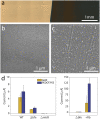PEDOT:PSS-based Multilayer Bacterial-Composite Films for Bioelectronics
- PMID: 30327574
- PMCID: PMC6191412
- DOI: 10.1038/s41598-018-33521-9
PEDOT:PSS-based Multilayer Bacterial-Composite Films for Bioelectronics
Abstract
Microbial electrochemical systems provide an environmentally-friendly means of energy conversion between chemical and electrical forms, with applications in wastewater treatment, bioelectronics, and biosensing. However, a major challenge to further development, miniaturization, and deployment of bioelectronics and biosensors is the limited thickness of biofilms, necessitating large anodes to achieve sufficient signal-to-noise ratios. Here we demonstrate a method for embedding an electroactive bacterium, Shewanella oneidensis MR-1, inside a conductive three-dimensional poly(3,4-ethylenedioxythiophene):poly(styrenesulfonate) (PEDOT:PSS) matrix electropolymerized on a carbon felt substrate, which we call a multilayer conductive bacterial-composite film (MCBF). By mixing the bacteria with the PEDOT:PSS precursor in a flow-through method, we maintain over 90% viability of S. oneidensis during encapsulation. Microscopic analysis of the MCBFs reveal a tightly interleaved structure of bacteria and conductive PEDOT:PSS up to 80 µm thick. Electrochemical experiments indicate S. oneidensis in MCBFs can perform both direct and riboflavin-mediated electron transfer to PEDOT:PSS. When used in bioelectrochemical reactors, the MCBFs produce 20 times more steady-state current than native biofilms grown on unmodified carbon felt. This versatile approach to control the thickness of bacterial composite films and increase their current output has immediate applications in microbial electrochemical systems, including field-deployable environmental sensing and direct integration of microorganisms into miniaturized organic electronics.
Conflict of interest statement
The authors declare no competing interests.
Figures






References
-
- Zhou AY, Zajdel TJ, Teravest MA, Maharbiz MM. A miniaturized monitoring system for electrochemical biosensing using Shewanella oneidensis in environmental applications. Proc. Annu. Int. Conf. IEEE Eng. Med. Biol. Soc. EMBS. 2015;2015:7518–7521. - PubMed
-
- Simonte Francesca, Sturm Gunnar, Gescher Johannes, Sturm-Richter Katrin. Advances in Biochemical Engineering/Biotechnology. Berlin, Heidelberg: Springer Berlin Heidelberg; 2017. Extracellular Electron Transfer and Biosensors. - PubMed
Publication types
MeSH terms
Substances
Grants and funding
- N000141310551/DOD | Office of Naval Research (ONR)/International
- N000141310551/DOD | Office of Naval Research (ONR)/International
- DE-AC02-05CH11231/U.S. Department of Energy (DOE)/International
- DE-AC02-05CH11231/U.S. Department of Energy (DOE)/International
- Project/Knut och Alice Wallenbergs Stiftelse (Knut and Alice Wallenberg Foundation)/International
LinkOut - more resources
Full Text Sources
Other Literature Sources
Miscellaneous

